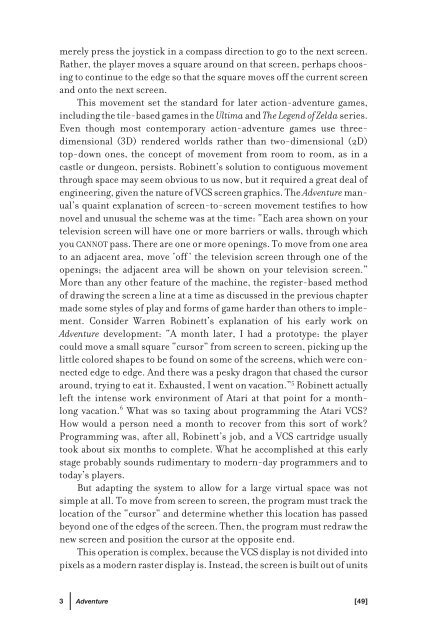Racing the Beam : the Atari Video Computer System - Index of
Racing the Beam : the Atari Video Computer System - Index of
Racing the Beam : the Atari Video Computer System - Index of
Create successful ePaper yourself
Turn your PDF publications into a flip-book with our unique Google optimized e-Paper software.
merely press <strong>the</strong> joystick in a compass direction to go to <strong>the</strong> next screen.<br />
Ra<strong>the</strong>r, <strong>the</strong> player moves a square around on that screen, perhaps choosing<br />
to continue to <strong>the</strong> edge so that <strong>the</strong> square moves <strong>of</strong>f <strong>the</strong> current screen<br />
and onto <strong>the</strong> next screen.<br />
This movement set <strong>the</strong> standard for later action-adventure games,<br />
including <strong>the</strong> tile-based games in <strong>the</strong> Ultima and The Legend <strong>of</strong> Zelda series.<br />
Even though most contemporary action-adventure games use threedimensional<br />
(3D) rendered worlds ra<strong>the</strong>r than two-dimensional (2D)<br />
top-down ones, <strong>the</strong> concept <strong>of</strong> movement from room to room, as in a<br />
castle or dungeon, persists. Robinett’s solution to contiguous movement<br />
through space may seem obvious to us now, but it required a great deal <strong>of</strong><br />
engineering, given <strong>the</strong> nature <strong>of</strong> VCS screen graphics. The Adventure manual’s<br />
quaint explanation <strong>of</strong> screen-to-screen movement testifi es to how<br />
novel and unusual <strong>the</strong> scheme was at <strong>the</strong> time: “Each area shown on your<br />
television screen will have one or more barriers or walls, through which<br />
you CANNOT pass. There are one or more openings. To move from one area<br />
to an adjacent area, move ‘<strong>of</strong>f ’ <strong>the</strong> television screen through one <strong>of</strong> <strong>the</strong><br />
openings; <strong>the</strong> adjacent area will be shown on your television screen.”<br />
More than any o<strong>the</strong>r feature <strong>of</strong> <strong>the</strong> machine, <strong>the</strong> register-based method<br />
<strong>of</strong> drawing <strong>the</strong> screen a line at a time as discussed in <strong>the</strong> previous chapter<br />
made some styles <strong>of</strong> play and forms <strong>of</strong> game harder than o<strong>the</strong>rs to implement.<br />
Consider Warren Robinett’s explanation <strong>of</strong> his early work on<br />
Adventure development: “A month later, I had a prototype: <strong>the</strong> player<br />
could move a small square “cursor” from screen to screen, picking up <strong>the</strong><br />
little colored shapes to be found on some <strong>of</strong> <strong>the</strong> screens, which were connected<br />
edge to edge. And <strong>the</strong>re was a pesky dragon that chased <strong>the</strong> cursor<br />
around, trying to eat it. Exhausted, I went on vacation.” 5 Robinett actually<br />
left <strong>the</strong> intense work environment <strong>of</strong> <strong>Atari</strong> at that point for a monthlong<br />
vacation. 6 What was so taxing about programming <strong>the</strong> <strong>Atari</strong> VCS?<br />
How would a person need a month to recover from this sort <strong>of</strong> work?<br />
Programming was, after all, Robinett’s job, and a VCS cartridge usually<br />
took about six months to complete. What he accomplished at this early<br />
stage probably sounds rudimentary to modern-day programmers and to<br />
today’s players.<br />
But adapting <strong>the</strong> system to allow for a large virtual space was not<br />
simple at all. To move from screen to screen, <strong>the</strong> program must track <strong>the</strong><br />
location <strong>of</strong> <strong>the</strong> “cursor” and determine whe<strong>the</strong>r this location has passed<br />
beyond one <strong>of</strong> <strong>the</strong> edges <strong>of</strong> <strong>the</strong> screen. Then, <strong>the</strong> program must redraw <strong>the</strong><br />
new screen and position <strong>the</strong> cursor at <strong>the</strong> opposite end.<br />
This operation is complex, because <strong>the</strong> VCS display is not divided into<br />
pixels as a modern raster display is. Instead, <strong>the</strong> screen is built out <strong>of</strong> units<br />
3 Adventure [49]


